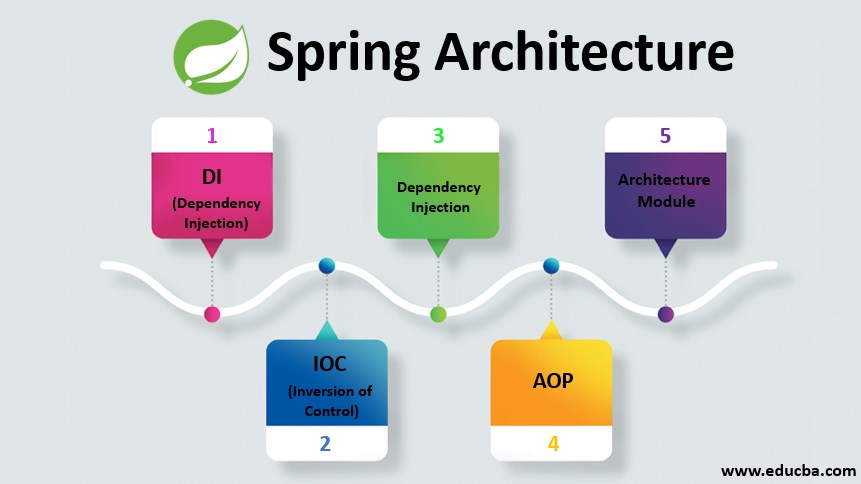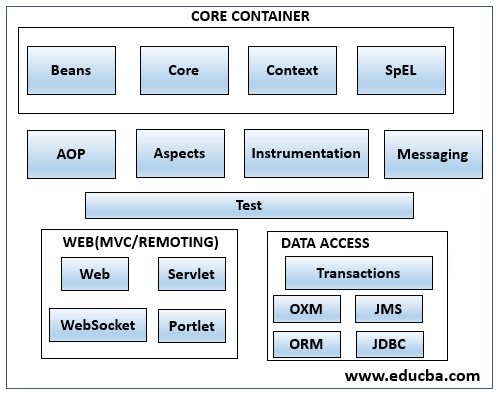Updated March 23, 2023

Introduction to Spring Architecture
Spring Architecture is nothing but an easy access workspace that supports the Java Enterprise creations in order to design, build, program and implement java based applications. The multiple layers with which the Spring Architecture is built are the Core Module, the AOP Module, the DAO Module, the ORM Module and the Web Module. There modules have divided compartments. For instance, the core module consists of the context, the language expression container, Beans & SpEI, and the web module consists of the Web-MVC Web-Socket and the Web-Portlet.
Architecture of Spring Framework
Before jumping to the architecture of spring, we should know the following term:
1. DI
It is difficult to comprehend what is Spring Framework without understanding what Dependency Injection and Inversion of Control is. Likewise, Dependency Injection is one of the kinds of Inversion of Control (IoC).
2. IOC (Inversion of Control)
This is the standard of object-oriented programming, wherein objects of the program don’t rely upon solid executions of different objects; however, they may know about their abstractions (interfaces) for the later association.
3. Dependency Injection
It is a piece of basic structure designs, in which for each capacity of the application, there is one, a restrictively autonomous item (administration) that can want to utilize different articles (conditions) known to it by interfaces. Conditions are moved (actualized) to the administration at the hour of its creation. This is where we present a component of one class into another. Practically speaking, DI is actualized by passing parameters to the constructor or utilizing setters. Libraries that execute this methodology are additionally called IoC containers.
4. AOP
It is a piece of basic structure designs, in which for each capacity of the application, there is one, a restrictively autonomous item (administration) that can want to utilize different other objects (dependencies) known to it by interfaces. Dependencies are moved (implemented) to the administration at the hour of its creation. This is where we present a component of one class into another.
5. Architecture Module
- The Core Module: Provides the Dependency Injection (DI) include the Spring system’s fundamental idea. This module contains the Bean Factory, an execution of Factory Pattern, which makes the bean according to the designer’s setups in an XML record.
- AOP Module: The Aspect-Oriented Programming module enables engineers to characterize technique interceptors and point slices to keep the worries separated. It is arranged at run time, so the accumulation step is skipped. It focuses on the explanatory exchange of the executives, which is simpler to keep up.
- DAO Module: This gives a reflection layer to the low-level assignment of making an association, discharging it and so forth. It additionally keeps up a chain of command of important exemptions instead of tossing confounded blunder codes from explicit database sellers. It utilizes AOP to oversee exchanges. Exchanges can likewise be overseen automatically.
- ORM Module: Spring doesn’t give its own ORM execution however offers mixes with mainstream Object-Relational mapping devices like Hibernate, iBATIS SQL Maps, Oracle TopLink and JPA and so on.
- Web Module: Spring accompanies MVC structure which facilitates the undertaking of creating web applications. It likewise incorporates well with the most mainstream MVC structures like Struts, Tapestry, JSF.
Now let’s discuss the architecture diagram in details below:
Spring Core Container
Core Container has the following aspects:
- Core
- Beans
- Context
- AOP
- SpEl
- Expression Language modules (Aspects)
The Core and Beans modules give the structure’s essential bits, including the IoC and Dependency Injection features. The Bean Factory is a propelled use of the creation line structure. It clears the necessity for programmed singletons and empowers you to decouple the structure and of conditions from your genuine program method of reasoning. The Context module develops the Core and Beans modules’ solid base: it is an approach to get to objects in a structure style way that resembles a JNDI library.
The Application Context interface is the purpose of the intermingling of the Context module. The Expression Language module gives a stunning verbalization language to addressing and controlling an article outline at runtime. It is a development of the bound together explanation language (united EL) as decided in the JSP 2.1 assurance.
The language supports setting and getting property estimations, property task, method call, getting to the setting of bunches, varieties and indexers, reasonable and number shuffling managers, named variables, and recuperation of things by name from Spring’s IoC compartment.
Information(Data) Access/Combination(Integration)
Identity and Access Management (IAM) is a vital component of data security for any enterprise, serving as a centralized portal. Some of the components are discussed in the following:
- JDBC: It provides a JDBC-reflection layer that clears the need to do monotonous JDBC coding and parsing of database-trader unequivocal bungle codes.
- ORM: It provides a blend layer to standard item communal plot APIs that contain JPA, JDO, Hibernate, and iBatis. Using the ORM group, you can use these O/R-mapping frameworks in the mix with the whole of various features Spring offers, for instance, the clear, authoritative trade the board incorporates referenced as of now.
- OXM: It provides a casting layer that supports Object and XML plotting utilization for JAXB, Castor, XMLBeans, JiBX, and XStream.
- JMS: It provides features for conveying and consuming messages.
Web
The web has the following layers:
- Web
- Web-MVC
- Web-Socket
- Web-Portlet
Spring Web: It gives fundamental web-arranged fuse features; for instance, multipart archive moves convenience and the presentation of the IoC holder using servlet crowd individuals and a web-organized application setting.
Web Servlet: It has Spring’s MVC execution for web applications.
Web Socket: Module contains the assistance classes for organizing a model Struts web level inside a Spring application.
Conclusion – Spring Architecture
In this article, we have presented with Spring Architecture, its engineering and fundamental highlights. We have figured out how the Spring structure causes us to grow loosely coupled applications utilizing dependency injection where the dependent objects are infused using a configuration file. The Spring system is a direct basic, lightweight, and strong structure to assemble present-day Java-based applications to put it plainly.
Recommended Articles
This is a guide to Spring Architecture. Here we discuss the Introduction to Spring Architecture and its engineering and fundamental highlights. You can also go through our other suggested articles to learn more –

